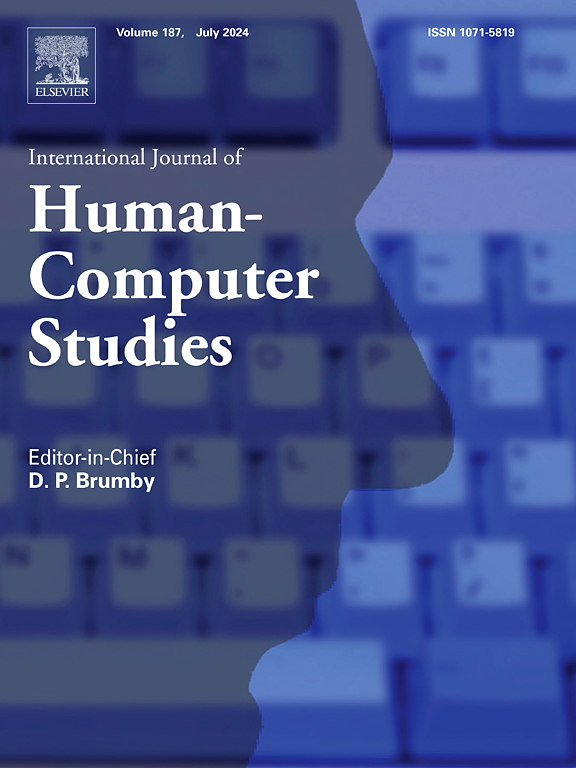传感器和敏感性:探索野生环境生理传感眼镜与栖息地舒适度的相互作用
IF 5.3
2区 计算机科学
Q1 COMPUTER SCIENCE, CYBERNETICS
International Journal of Human-Computer Studies
Pub Date : 2025-04-17
DOI:10.1016/j.ijhcs.2025.103510
引用次数: 0
摘要
建筑物越来越多地采用传感和驱动技术来自动调节温度、照明、通风等。这一趋势旨在最大限度地减少人为干预,并承诺加强能源优化。然而,人们普遍认为,失去对环境条件的控制可能导致舒适度的降低,并损害用户的长期意识和满意度。我们如何设想建筑系统能够与建筑居民互动,并在“正确”的时间和地点吸引他们?在这项工作中,我们通过三个关键贡献来解决这一挑战:1)AirSpecs,一种基于智能眼镜的新型系统,可以全面感知室内环境质量(IEQ)和生理数据;2)使用外围LED灯和提议的舒适度感知过程来评估环境意识的客观方法;3)解决舒适度流动性的设计影响。在五天的时间里,来自三大洲的30名参与者使用了AirSpecs设备及其配套的移动应用程序。通过对用户交互、体验后调查、访谈和共同设计会议的混合方法分析,我们展示了研究结果和设计场景,展示了我们在未来智能建筑中提高居住者参与度和舒适度的潜力。本文章由计算机程序翻译,如有差异,请以英文原文为准。

Sensors and Sensibilities: Exploring Interactions for Habitat Comfort with An Environmental-Physiological Sensing Eyewear In the Wild
Buildings increasingly incorporate sensing and actuation techniques to automate the regulation of temperature, lighting, ventilation, and more. This trend seeks to minimize human intervention, justified by the promise of enhancing energy optimization. However, it has been widely acknowledged that loss of control over environmental conditions can lead to a diminished perception of comfort and compromised long-term user awareness and satisfaction. How can we envision building systems that can interact with building inhabitants and engage them at the “right” time and place? In this work, we address this challenge through three key contributions: 1) AirSpecs, a novel smart glasses-based system that enables holistic sensing of Indoor Environmental Quality (IEQ) and physiological data, 2) an objective method for assessing environmental awareness using a peripheral LED light and a proposed comfort awareness process, and 3) design implications for addressing the fluidity of comfort. Over five days, 30 participants across three continents used the AirSpecs device and its accompanying mobile application. Through a mixed-methods analysis of user interactions, post-experience surveys, interviews, and co-design sessions, we present findings and design scenarios that demonstrate the potential of our contributions to enhance occupant engagement and comfort in smart buildings in the future.
求助全文
通过发布文献求助,成功后即可免费获取论文全文。
去求助
来源期刊

International Journal of Human-Computer Studies
工程技术-计算机:控制论
CiteScore
11.50
自引率
5.60%
发文量
108
审稿时长
3 months
期刊介绍:
The International Journal of Human-Computer Studies publishes original research over the whole spectrum of work relevant to the theory and practice of innovative interactive systems. The journal is inherently interdisciplinary, covering research in computing, artificial intelligence, psychology, linguistics, communication, design, engineering, and social organization, which is relevant to the design, analysis, evaluation and application of innovative interactive systems. Papers at the boundaries of these disciplines are especially welcome, as it is our view that interdisciplinary approaches are needed for producing theoretical insights in this complex area and for effective deployment of innovative technologies in concrete user communities.
Research areas relevant to the journal include, but are not limited to:
• Innovative interaction techniques
• Multimodal interaction
• Speech interaction
• Graphic interaction
• Natural language interaction
• Interaction in mobile and embedded systems
• Interface design and evaluation methodologies
• Design and evaluation of innovative interactive systems
• User interface prototyping and management systems
• Ubiquitous computing
• Wearable computers
• Pervasive computing
• Affective computing
• Empirical studies of user behaviour
• Empirical studies of programming and software engineering
• Computer supported cooperative work
• Computer mediated communication
• Virtual reality
• Mixed and augmented Reality
• Intelligent user interfaces
• Presence
...
 求助内容:
求助内容: 应助结果提醒方式:
应助结果提醒方式:


